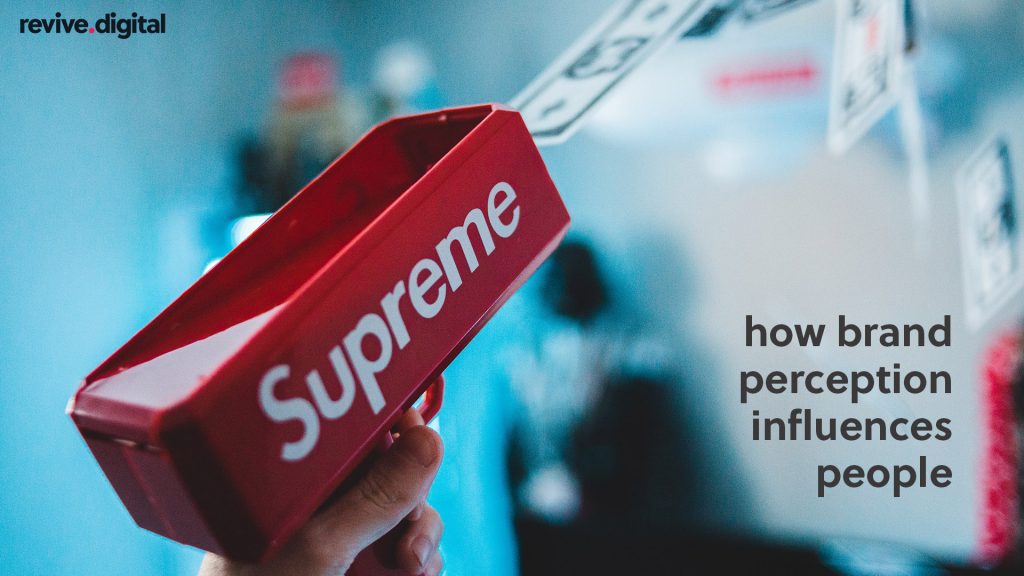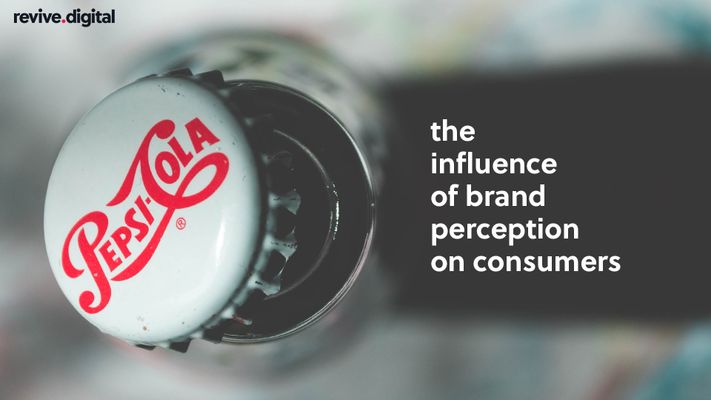The Influence of Brand Perception on Your Consumers
There's usually a disconnect between the way a business sees its brand and the way people, including the people who work there, view it. Not always, but more often than not. If you don't already know this, your brand perception is a massive influence on the way your audience sees your business. And it affects how they interact with it.
Before the world got digital, brands could control their image much easier. Now, a quick internet search reveals things like reviews or social media conversations – both positive and negative – to show just whether your brand is living up to its professed values.
Potential customers or service users can see all those reviews and make an informed decision whether the company is 'towing the line' or the customers themselves are being unfair.
The two-way conversations means brands can and will get pulled up if it's found out they are not who they claim to be.
Buying in to Brand Perception
It may feel like a waste of money putting budget behind your brand and understanding your brand perception, but it's crucial, even as a small business. Your brand is one of your most valuable assets. When the factory burns down, as advertiser David Ogilvy puts it, the brand is all that's left...
… it's not your logo. And it's not your colours.
It's bigger than a visual identity.
And while these things are part of your brand, they don't define your brand itself. Neither do your aspirations as a business – 'we want to offer the best customer service in XYZ industry...' just won't cut it as a unique direction anymore (when did you ever hear a business actively promoting bad customer service?).
To make a brand work people have to believe in your brand. Not just see it. It must live in a consumer's mind. Their perception has to match the business personality. That comes down to positioning and your company values.
What is a Brand?
There are many definitions of what is branding. Marketer Ivan Levison, described it as a mental franchise that stays deeply embedded in the prospect's mind.
He said: “When we speak of promoting a 'brand,' we're not really talking about mere products sitting on a shelf. We're actually referring to a set of beliefs that the prospect has developed about a product or company over time.”
And it's those beliefs that create loyalty, which in turn become sales, providing you with a share of your customer's wallet. Once people believe in a brand (… in you...) they'll repay you and champion your brand.
A brand's value is measured as brand equity. It uses things like brand awareness, brand loyalty and the associations people make when connecting with a brand.
So when businesses buy other businesses, the loyalty of the customer base is seen as one of the key gains and most powerful assets. After all, are you're not really after a warehouse full of products. You need a business with loyal and spending customers?

How Brand Perception Influences Consumers
A very typical example of brand alignment, the notion of consumers attaching themselves to a particular brand, is with supermarket own brand vs branded food products. Certain supermarkets use blind taste tests to market their products with the results showing surprised faces as consumers are told the one they liked the best was a supermarket own brand. It's a common drill.
There is even a TV show doing a similar thing where people swear they can tell their usual branded cereal, drink etc from the imposters... "that's not my usual brand". Really?
But branding and how people perceive brands in the context of their own lives does have a major impact on their behaviour:
- It's perceived by some people that the brands they choose makes them status symbols
- People covet great brands and popular brands
- Branding affects self image and self esteem too. Some brands are perceived to help low self-esteem, while others might validate existing self-esteem. People buy into brands they believe will support their self-image and values
An Exclusive Club
Buying into a brand is almost like being a member of an exclusive club. While the brand may not be 'exclusive' in that high-quality sense of the word, buying into a brand adds a sense of social proof; you're in a gang now. Brand alignment is powerful and is almost a form of camaraderie.
It's worth noting too that in blind taste tests, once a tester has seen the brand they tend to feel more favourable towards the bigger, more advertised brands. the perception is bigger brands, or more visible brands perhaps, are better.
Brand Perception - Coke vs Pepsi
In the 80s new kid on the block Pepsi managed a marketing triumph over it's rival Coke. Pepsi set up a number of blind taste tests in malls around the USA. Passers-by were invited to pick their favourite from two choices of cola, one being coke the other being Pepsi.
The results were genuine too. People preferred the taste of Pepsi.
Coke floundered, had a PR disaster, tried to reformulate the flavour (which got them 400,000 letters of complaint and legal action from a bottling company for changing the formula), and eventually went back to the original flavour.
So why, if Pepsi is considered the better tasting of the two drinks, is Pepsi not the market leader of the two brands?
Branding. Coke works hard to be one of the most recognised brands in the world. Pepsi isn't as well recognised. And it pays in sales.
Your Brand Associations
Consumers making positive associations with your brand can help build your business in a variety of ways.
- It can help you better position your products
- It can offer ways to communicate new information
- It can help your products stand out
- It creates positive feelings towards your brand
- It can help you create extensions of existing product lines

Key Factors in Your Branding Success
We mentioned earlier that positioning and values were key drivers in how your brand is built and perceived by consumers.
Positioning
The Dove range of skincare could have been positioned in a more functional, medical way – as a cream to fight skin conditions such as eczema or psoriasis. It wasn't. Dove was positioned as a beauty product.
But in keeping with the earlier drinks theme Red Bull positioned itself superbly, in a functional and emotional way, creating a new category in a drinks market dominated by Pepsi and Coke. Red Bull is now a $3 billion business thanks to the content marketing revolution from Red Bull Media House and by creating a brand story that's utterly compelling.
By owning numerous major teams across a variety of sports, Red Bull are positioning the functional side of their product – one that stimulates the mind and increases alertness in high level athletes. On the other hand they have created a fun side to tap into consumer's emotions with the Soap Box Races and their slogan 'Red Bull Gives You Wiiings'.
Values
Right at the core of your branding are your brand values. They decide things like your brand personality and your marketing messages. They should guide your brand story. You must be continually delivering those values, and consistently too.
It's easy to get it wrong. The bigger the company, the harder it is to keep messages consistent. And this is how your consumer's may begin to perceive your brand as different to that you really want to showcase.
It's really worth thinking about your values. It's how your consumers will see your brand and they'll decide if they want to align with it.
To kickstart your brand values, you need a business mission statement or vision. And it's how you will find differentiation in a busy marketplace.
Your Brand Wasn't Built in a Day
Your brand is built over a period of time, created bit by bit from the impressions consumers have of your company, its products and services. Good experiences support it, bad ones damage it.
And these days there are plenty of brands to choose from. It wouldn't be wrong to say they are overwhelmed with choice.
Brand perception is important in creating loyalty, which in turn can help provide financial stability and prevent competitors from taking market share. To keep you at an advantage in the market your brand is business asset that must be nurtured.
Crucially, your brand perception delivers information about your products subconsciously which affects the decisions of your consumers when they engage with you.
Without that mental relationship, how can brands hope to distinguish themselves?
A Final Word From our Head of Creative
"Think about this. If you were to buy a coffee and had the choice between Costa and Starbucks, what would determine which doorway you'd walk through? It could be the price? Taste? Or maybe it could be the brand, the one which resonates with your personality. "Brand identity is one thing - you could hire the most expensive designer in the world to create you the best-looking logo - but if you haven’t thought about how your brand behaves, what language it speaks, it may not make all that much difference. "Branding affects you in everyday life more than you imagine." James Higgs, Head of Creative at revive.digital At Revive we think about all these things and more when our clients approach us for branding work. And some of our favourite branding examples include Brewdog, Innocent, IKEA and Gymshark. As James puts it: "...mainly because they’ve nailed who their audience is and sussed out exactly how to speak to them. Now pour in the wonderfully executed graphics and you’ve got a winning formula." If you want to see ways we can help with your branding then get in touch. We love a chat anyway, even if it's got nothing to do with our range of digital marketing services. It's a bit like us stretching our 'mental legs'. So please do...













